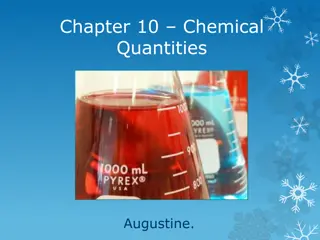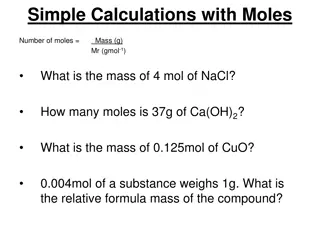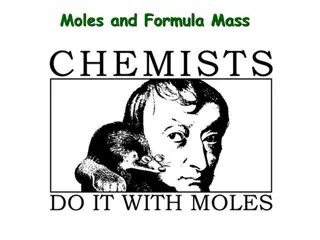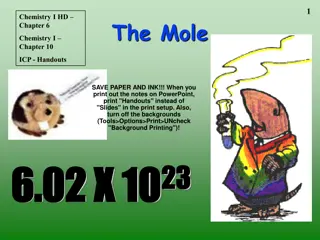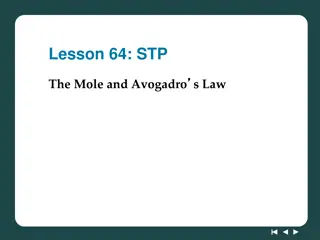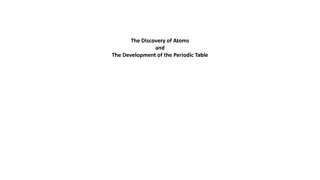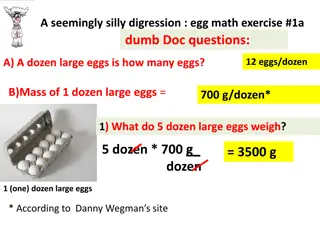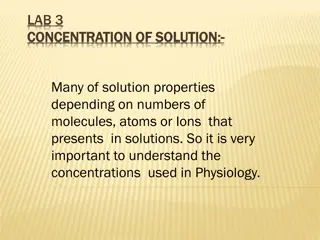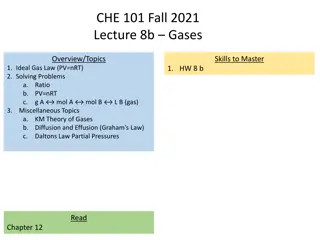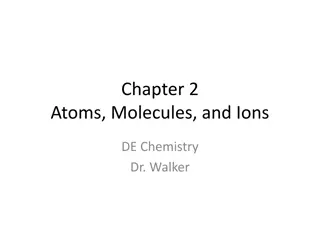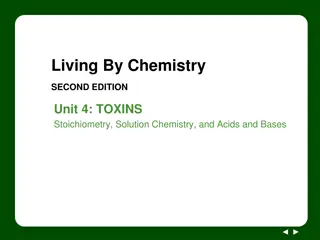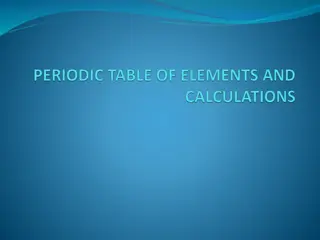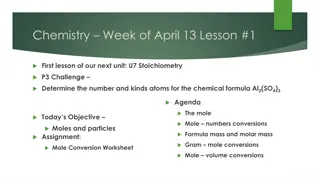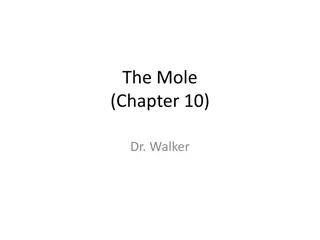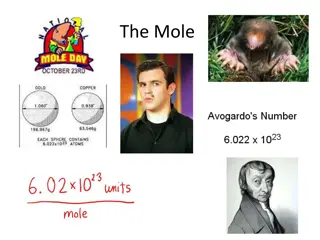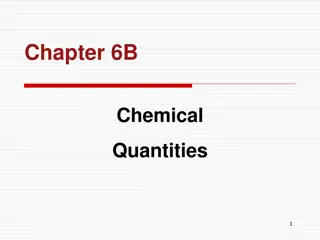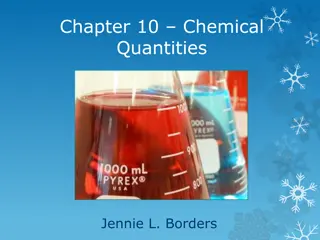Understanding Chemical Quantities: The Mole and Molar Mass
Explore the concept of chemical quantities through the mole and molar mass. Learn how to measure substances, calculate moles, find molar masses of compounds, and solve related problems in this informative chapter. Discover the significance of Avogadro's number, representative particles, and more in
7 views • 41 slides
Understanding Mole Calculations in Chemistry
Explore various mole calculations in chemistry such as determining mass from moles, moles from mass, and comparing particles in different substances. Learn how to calculate the mass of substances, the number of particles, and perform calculations using balanced equations. Dive into concepts like mol
0 views • 49 slides
Understanding Gas Laws: Boyle's, Charles', Gay-Lussac's, and Avogadro's Laws
Gas laws such as Boyle's Law, Charles' Law, Gay-Lussac's Law, and Avogadro's Law govern the behavior of gases under different conditions. Boyle's Law relates pressure and volume at constant temperature, Charles' Law relates volume and temperature at constant pressure, Gay-Lussac's Law relates pressu
1 views • 19 slides
Understanding Moles and Formula Mass in Chemistry
Dive into the world of moles, Avogadro's number, and formula mass calculations in chemistry. Learn how to convert moles to grams, grams to moles, and determine the number of atoms using Avogadro's number. Explore the concepts of formula mass and percentage composition to understand the composition o
0 views • 19 slides
Exploring the Mole: A Fascinating Dive into Chemistry Concepts
Delve into the world of chemistry with a focus on the mole, stoichiometry, Avogadro's number, and the quantitative aspects of chemical reactions. Explore the significance of 6.02 x 10^23, learn about the origins of Avogadro's number, and grasp the vastness of a mole through intriguing analogies. Dis
0 views • 33 slides
Understanding the Mole and Avogadro's Law at Standard Temperature and Pressure (STP)
The lesson delves into the concepts of mole and Avogadro's law in relation to gases at standard temperature and pressure (STP). It explains how chemists track the number of gas particles using the mole unit, and highlights the significance of STP in gas calculations. Equal volumes of gases contain e
0 views • 9 slides
Understanding the States of Matter and Properties of Gases
Matter can be classified into gas, liquid, and solid based on particle arrangement, shape, and motion. Gases in pharmacy are crucial for various applications like anesthesia and aerosols. Properties of gases include compressibility, pressure exertion, diffusion, and expansion. Gas laws such as Boyle
0 views • 22 slides
Exploring Atoms, Elements, and the Periodic Table
Delve into the fascinating world of atoms and the periodic table with experiments on magnesium and zinc oxides. Discover how different elements combine to form compounds and analyze their composition. Learn about the relative atomic weights according to historical figures like John Dalton and Amadeo
0 views • 17 slides
Understanding Gas Laws and Avogadro's Contributions
This chapter delves into the molecular composition of gases, exploring topics such as volume-mass relationships, Gay-Lussac's studies on gas volumes in reactions, the law of combining volumes of gases, and Avogadro's groundbreaking findings. Gay-Lussac's work posed challenges to Dalton's atomic theo
0 views • 82 slides
The Equivalence of Egg Math and Mole Math
Explore the interesting comparison between egg math and mole math, where 1 egg is equivalent to one practical counting unit in the world of chemistry. Discover how a chemist's dozen relates to the Avogadro's number and molecular weight, highlighting the parallel between egg quantities and chemical e
1 views • 21 slides
Understanding Concentration of Solutions in Physiology
Concentration of solutions is crucial in understanding the properties of substances in Physiology. This involves concepts like percentage solutions and molar solutions, where the amount of solute is measured in grams or moles relative to the volume of the solution. Percentage solutions are commonly
0 views • 8 slides
Understanding the Ideal Gas Law in Chemistry
Explore the concepts of the ideal gas law, including Avogadro's principle and gas stoichiometry at non-STP conditions. Learn how to apply the law to calculate pressure, volume, and moles of gases under various conditions with practical examples provided.
0 views • 13 slides
Comprehensive Overview of Ideal Gas Law and Gas Problems
Delve into a detailed exploration of the Ideal Gas Law and its applications in solving various gas-related problems. Master the concepts of Boyle's Law, Charles's Law, Avogadro's Law, and more through equation, ratio, and stoichiometry problems. Enhance your understanding of gas behavior and calcula
0 views • 20 slides
Chapter 2. Atoms, Molecules, and Ions
Explore the historical timeline of atomic theory advancements, from Demokritos' initial concept of "atomos" to Dalton's Atomic Theory, Thomson's discovery of the electron, and modern breakthroughs by scientists like Rutherford and Lawrence. Avogadro's contributions to the mole concept and gas laws a
0 views • 46 slides
Understanding Molar Mass and Avogadro's Number in Chemistry
Explore the concept of molar mass and Avogadro's number in chemistry through lessons on translating numbers into scientific notation, understanding moles, and finding molar mass on the periodic table. Discuss the relationship between mass and moles, differentiate between different quantities of a su
1 views • 11 slides
Understanding the Mole Concept in Chemistry
Delve into the world of chemistry with the Mole Concept, exploring molar mass, Avogadro's number, representative particles, and more. Learn how to determine molar mass for compounds and grasp the significance of a mole in chemical calculations.
0 views • 27 slides
Understanding Moles and Molar Quantities in Chemistry
Chemistry involves understanding atomic structure, chemical equations, and measurement units like moles. Avogadro's number, elemental composition, and compound formulas play crucial roles in calculating and using substances in chemical reactions. Learn about the significance of mass numbers, moles,
0 views • 25 slides
Understanding Stoichiometry and The Mole Concept in Chemistry
Explore the fundamentals of stoichiometry and the mole concept in chemistry, including conversions between moles and particles, molar mass calculations, and gram mole conversions. Learn how to determine the number and kinds of atoms in chemical formulas and understand the significance of Avogadro's
0 views • 12 slides
Understanding the Concept of Molar Mass in Chemistry
Explore the concept of molar mass in chemistry, including the definition of the mole, Avogadro's number, calculations for molar mass of elements and compounds, and examples of determining molar mass. Discover how to find the molar mass of various compounds through practical examples.
0 views • 39 slides
Understanding Moles in Chemistry
Matter is composed of various particles, and chemists use the concept of moles as a unit of measure to quantify the number of particles in a substance. One mole is equal to 6.02 x 10^23 representative particles of a substance, known as Avogadro's number. Moles are versatile and applicable to differe
0 views • 25 slides
Understanding Chemical Quantities: The Mole Concept and Molar Mass
Chemists use the mole concept to relate mass and the number of atoms in chemical reactions. Avogadro's number, molar mass, stoichiometry, and energy changes in reactions are key concepts explored in this chapter. The mole is a vital unit in chemistry, enabling scientists to quantify substances and m
0 views • 77 slides
Understanding Chemical Quantities: The Mole Concept in Chemistry
Exploring the concept of the mole in chemistry, this chapter delves into measuring matter in terms of count, mass, or volume. Avogadro's number is defined, and representative particles such as atoms, molecules, and ions are discussed. The calculation of molar mass for elements and compounds is expla
0 views • 41 slides
